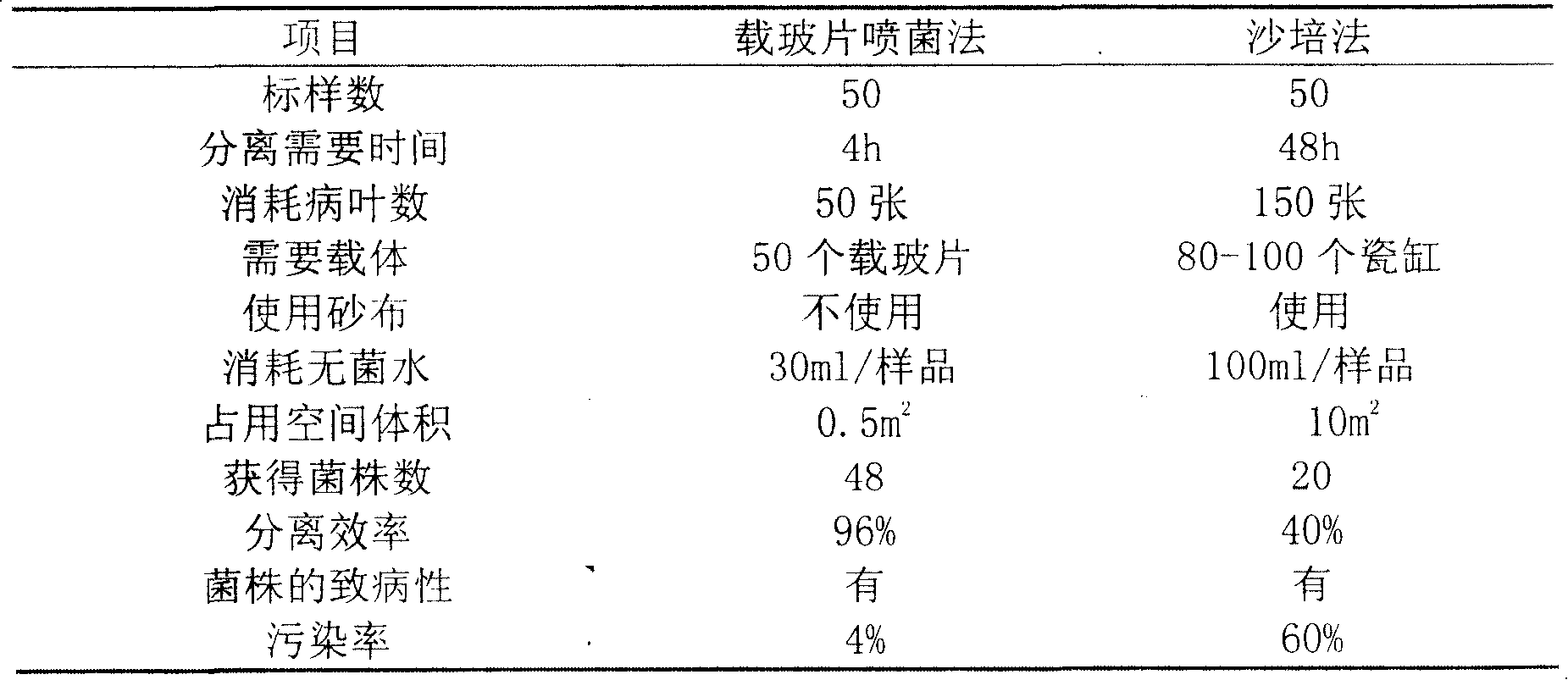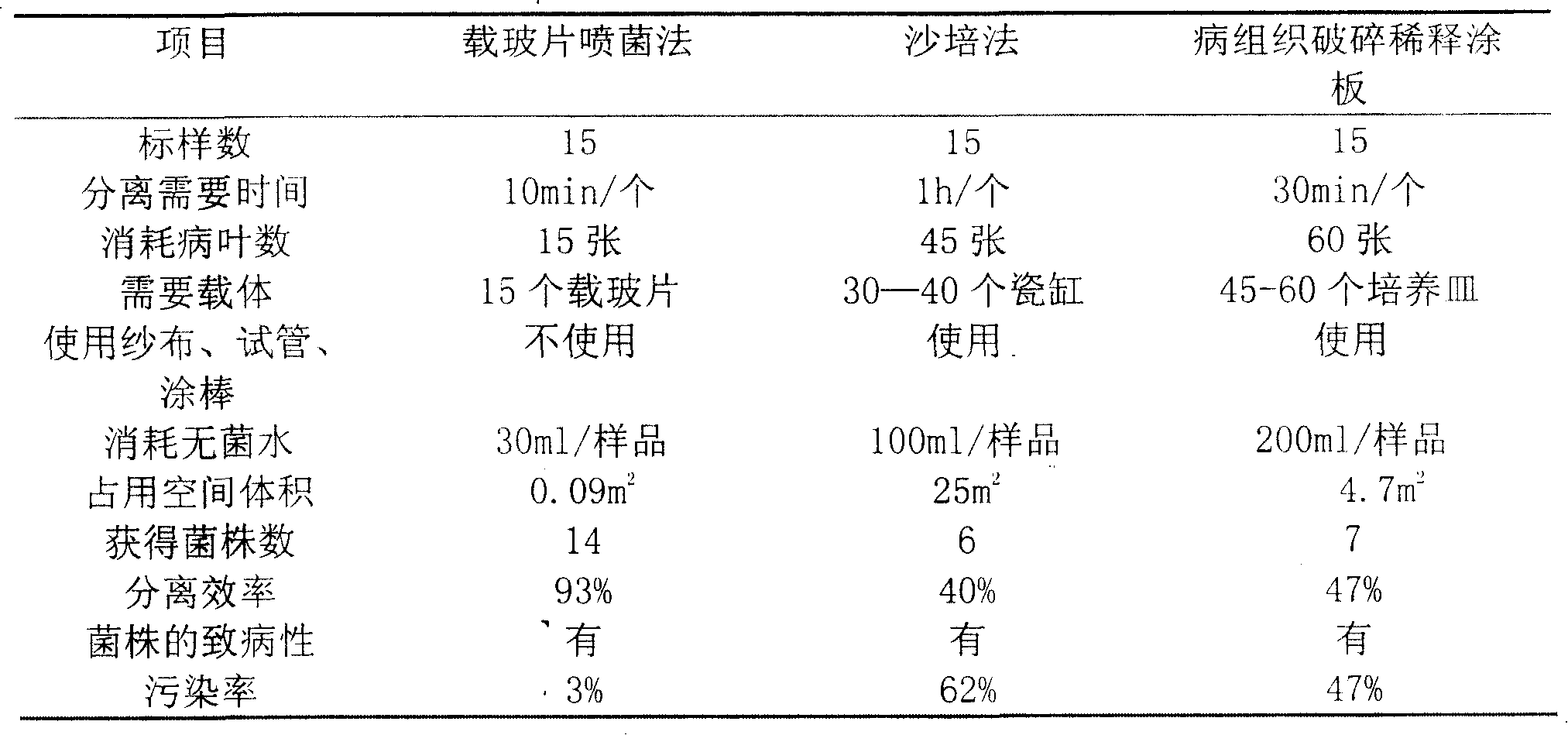Quick separation method for rice leaf spot bacteria
A technology for bacterial blight of rice and bacterial blight of rice is applied in the field of microorganisms, which can solve the problems of using consumables, consuming too many samples, wasting samples, and small sample volume, etc., so as to shorten the processing time, reduce the usage amount, and achieve a large number of samples. Effect
- Summary
- Abstract
- Description
- Claims
- Application Information
AI Technical Summary
Problems solved by technology
Method used
Image
Examples
Embodiment 1
[0016] The quick separation method of rice bacterial blight of the present invention, concrete steps are:
[0017] 1. Rapid isolation of bacterial blight of rice, the specific steps are as follows:
[0018] (1) Standard sample selection: select rice bacterial blight specimens with typical symptoms, and cut out 0.5cm tissue blocks at the junction of disease keys at the frontier of onset expansion;
[0019] (2) Disinfection: firstly rinse the tissue block with tap water, select 75% alcohol for disinfection for 60 seconds, then rinse it with sterile water for 3 times, and trim it with scissors after slightly drying to remove excess healthy tissue;
[0020] (3) Put the sterilized tissue block on a sterilized glass slide (soak the slide in 95% ethanol in advance, lightly burn it on an alcohol lamp before use), and drop 1 drop of sterile water on both ends , stand still at room temperature for 5 minutes, and after the bacteria spraying phenomenon appears, dip the bacteria-containin...
Embodiment 2
[0029] The quick separation method of rice bacterial blight of the present invention, its steps are:
[0030] 1. The rapid isolation method of bacterial blight of rice, the specific steps are as follows:
[0031] (1) Selection of standard samples: select samples of rice bacterial blight with typical symptoms, and cut out 1.5cm tissue blocks at the junction of disease keys at the frontier of onset expansion;
[0032] (2) Disinfection: firstly rinse the tissue block with tap water, select 75% alcohol for disinfection for 90 seconds, then rinse with sterile water for 3 times, and trim it with scissors after slightly drying to remove excess healthy tissue;
[0033] (3) Put the sterilized tissue block on a sterilized glass slide (soak the slide in 95% ethanol in advance, lightly burn it on an alcohol lamp before use), and drop 1 drop of sterile water on both ends , stand still at room temperature for 15 minutes, and after the phenomenon of bacteria spraying occurs, use a transfer ...
Embodiment 3
[0044] The quick separation method of rice bacterial blight of the present invention, its steps are:
[0045] 1. The rapid isolation method of bacterial blight of rice, the specific steps are as follows:
[0046] (1) Selection of standard samples: select samples of rice bacterial blight with typical symptoms, and cut out 1.0 cm tissue blocks at the junction of disease keys at the frontier of onset expansion;
[0047] (2) Disinfection: first rinse the tissue block with tap water, select 75% alcohol for disinfection for 75 seconds, then rinse with sterile water for 3 times, and trim it with scissors after slightly drying to remove excess healthy tissue;
[0048] (3) Put the sterilized tissue block on a sterilized glass slide (soak the slide in 95% ethanol in advance, lightly burn it on an alcohol lamp before use), and drop 1 drop of sterile water on both ends , stand still at room temperature for 10 minutes, and after the phenomenon of bacteria spraying occurs, use a transfer r...
PUM
| Property | Measurement | Unit |
|---|---|---|
| diameter | aaaaa | aaaaa |
| length | aaaaa | aaaaa |
| separation | aaaaa | aaaaa |
Abstract
Description
Claims
Application Information
 Login to View More
Login to View More - R&D
- Intellectual Property
- Life Sciences
- Materials
- Tech Scout
- Unparalleled Data Quality
- Higher Quality Content
- 60% Fewer Hallucinations
Browse by: Latest US Patents, China's latest patents, Technical Efficacy Thesaurus, Application Domain, Technology Topic, Popular Technical Reports.
© 2025 PatSnap. All rights reserved.Legal|Privacy policy|Modern Slavery Act Transparency Statement|Sitemap|About US| Contact US: help@patsnap.com



